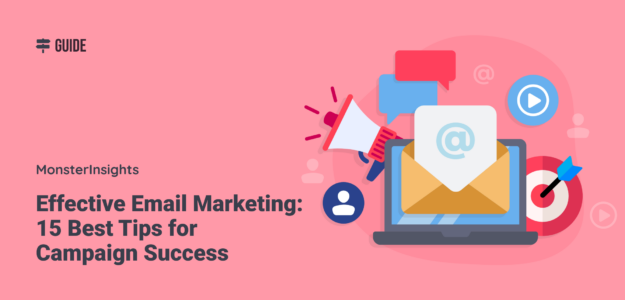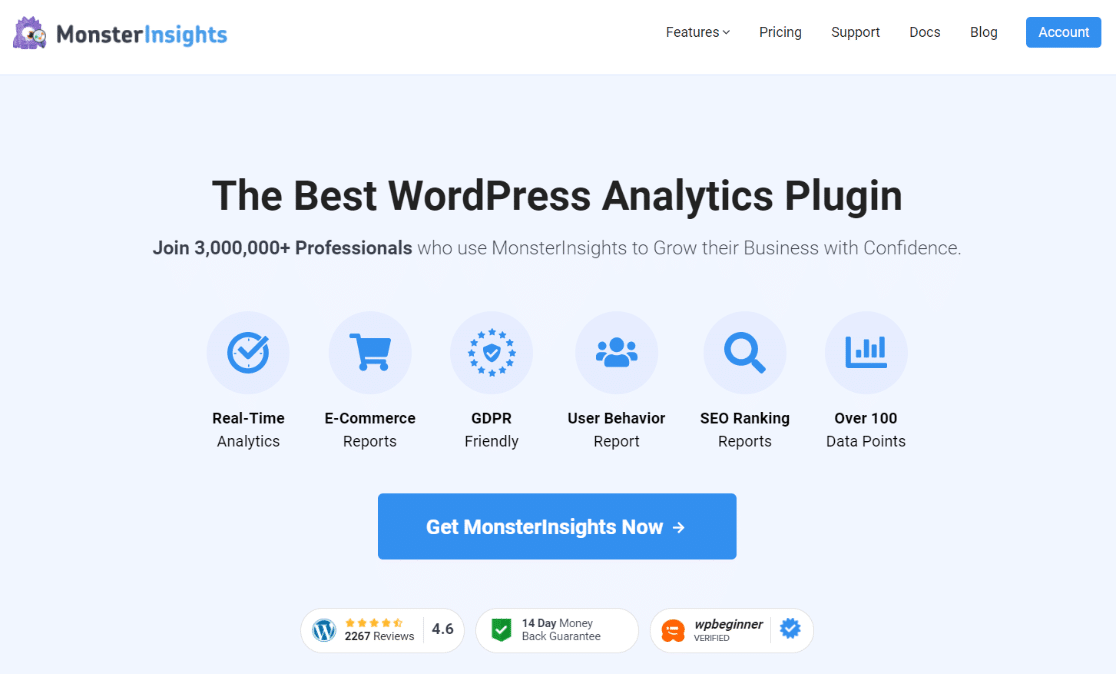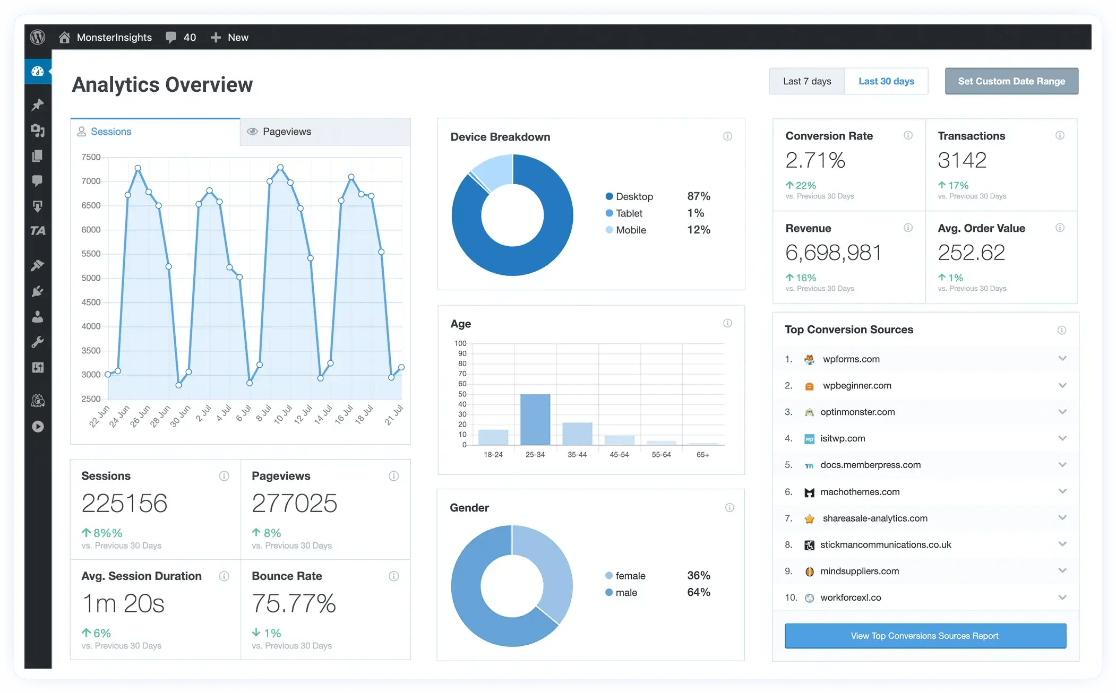Are you looking for some effective email marketing strategies to connect with more customers?
Email marketing can initially seem difficult, but with the right tips and strategies, you can create email campaigns that engage your audience, drive sales, and grow your business.
In this article, we’ll explore 15 tips for effective email marketing for small businesses. Whether new to email marketing or looking to improve your skills, these tips will help you succeed.
Let’s dive in!
Is Email Marketing Still Effective?
It’s a hot topic whether email marketing is still effective, but the short answer is, ‘Yes, it is!’
In fact, for every $1 spent, you can expect an average return of $36. Email marketing is great for reaching your audience, driving sales, and building lasting relationships.
Here are some of the best benefits:
- Cost-effective marketing strategy: Email marketing lets you reach many people at a low cost. It’s cheaper than traditional advertising and offers a great return on investment.
- Targeted and personalized communication: You can send messages tailored to different groups of people. Segment your audience based on interests and behaviors for more relevant and engaging emails.
- Build customer relationships: Regular emails keep you connected with your customers. Send newsletters, offers, and updates to build trust and loyalty.
- Measurable and trackable results: Track who opens your emails, clicks on links, and makes purchases. This helps you understand what works and improves future campaigns.
- Boosts sales and conversions: Well-planned emails can guide people through buying. Sending welcome emails or discount offers can boost sales.
- Improves brand awareness and reach: Email marketing helps you reach a global audience. With billions of email users worldwide, you can introduce your brand to many potential customers.
Email marketing is a powerful tool for any large or small business. It’s cost-effective, personalized, and helps build strong customer relationships. Plus, it’s easy to track and measure, making it a smart choice for any marketing strategy.
Next, we’ll take a look at some effective strategies and tips for your email marketing campaigns.
15 Best Tips for Campaign Success
Ready to make your email marketing campaigns better?
Let’s explore the top strategies for email marketing success. These tips will help you create successful campaigns that engage your audience and drive results.
Here’s what we’ll cover:
- Segment Your Audience
- Personalize Your Emails
- Write Compelling Subject Lines
- Clean Your Email List Regularly
- Re-Engage Inactive Subscribers
- Optimize Your CTAs (Calls-to-Action)
- Use Visuals and Images
- Automate Your Email Campaigns
- Send Emails at the Best Time
- A/B Test Your Email Content
- Track the Right Metrics
- Connect with Social Media
- Provide Value in Every Email
- Optimize for Mobile
- Use Customer Feedback and Surveys
1. Segment Your Audience
First up is segmentation.
Segmenting your audience means dividing your email list into smaller groups based on specific criteria so you can send more personalized and relevant emails to each group.
Why is segmentation so important?
First, it lets you personalize your messages, making them resonate better with your recipients. For instance, sending birthday discounts or product recommendations based on past purchases can make your emails more tailored and special.
Segmented emails also tend to have higher open and click-through rates because the content is more relevant to the reader.
This relevance can lead to better conversion rates, as people are likelier to act on an email that speaks directly to their interests or needs. Additionally, subscribers are less likely to unsubscribe when your emails are relevant, helping you maintain a healthy and engaged email list.
To segment effectively, consider demographics such as age, gender, or location.
For example, a clothing store might send different emails to teenagers than adults. You can also look at behavior, such as past purchases or website activity. If someone recently bought a camera, you could send them tips or suggest related accessories.
Finally, consider your subscribers’ lifecycle stages. New subscribers might appreciate a welcome series, loyal customers might be interested in exclusive offers, and inactive users might need re-engagement campaigns.
By segmenting your audience, you ensure your emails are more relevant and engaging, leading to better results and stronger connections with your subscribers.
2. Personalize Your Emails
Personalizing your emails is more than just adding a recipient’s name to the greeting. It involves using customer data to tailor the content of your emails to each subscriber’s interests and behaviors.
To start personalizing your emails, use the data you have about your customers. This might include their purchase history, browsing behavior, location, and preferences.
For example, if you run an online bookstore, you can recommend new books based on what customers have purchased or browsed.
Similarly, if you have an eCommerce store, you can send personalized product recommendations or special offers based on customers’ interests.
Here are some examples of personalized content:
- Product recommendations: ‘We thought you might like these items based on your recent purchase.’
- Birthday offers: ‘Happy Birthday! Here’s a special discount just for you.’
- Location-based content: ‘Check out our upcoming events in your area.’
- Behavioral triggers: ‘We noticed you left some items in your cart. Here’s a special offer to complete your purchase.’
Using customer data to personalize your emails makes your subscribers feel valued and understood. This can foster stronger relationships and lead to higher open rates, click-through rates, and conversions.
3. Write Compelling Subject Lines
Your subject line is the first thing your subscribers see, so it needs to grab their attention and make them want to open your email.
A compelling subject line significantly increases your open rates and sets the tone for the content.
Tips for creating catchy subject lines:
- Keep it short and sweet: Aim for 6-10 words to ensure your subject line isn’t cut off, especially on mobile devices.
- Create a sense of urgency: Use words encouraging immediate action, like ‘limited time offer’ or ‘expires soon.’
- Be clear and direct: Let readers know exactly what they can expect inside the email.
- Add personal touches: Include the recipient’s name or reference something specific to them.
- Use emojis sparingly: Emojis can make your subject line stand out, but don’t overdo it.
AI tools can help you craft more effective subject lines by analyzing what works best.
Tools like Phrasee, CoSchedule’s Headline Analyzer, or SubjectLine.com can provide insights and suggestions based on data and trends.
Examples of boring vs. better subject lines:
- Boring: ‘New Product Update’
- Better: ‘Don’t Miss These July Surprises 🎉’
- Boring: ‘Discount on Items’
- Better: ‘Flash Sale! Get 30% Off Today Only’
Writing compelling subject lines increases the chances of people opening and reading your emails. This is the first step in engaging your audience and converting them into customers.
4. Clean Your Email List Regularly
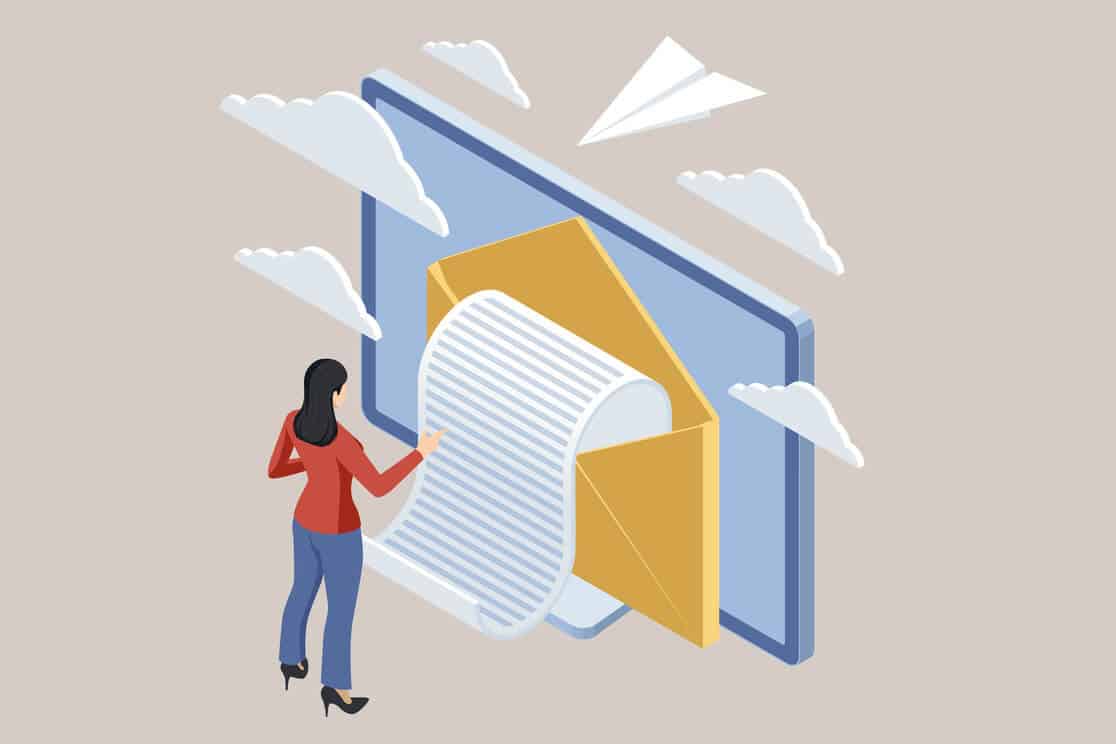
Maintaining a clean email list is essential for the success of your email marketing campaigns.
One of the main benefits of keeping your email list clean is that it helps you avoid sending emails to inactive subscribers.
These inactive subscribers can harm your sender’s reputation and cause your emails to land in spam folders – which is not where you want them!
Additionally, cleaning your list can save you money, as many email service providers charge based on the number of subscribers you have.
To keep your list clean, start by identifying inactive subscribers. Look for those who haven’t opened or clicked on any of your emails in the past six months to a year.
Once you’ve identified these inactive users, you can re-engage or remove them. We’ll discuss re-engaging them shortly.
Regularly cleaning your email list ensures you’re only communicating with those genuinely interested in your content, leading to more effective and successful email marketing campaigns.
5. Re-Engage Inactive Subscribers
As mentioned above, you don’t want inactive subscribers, and a good strategy is to try to re-engage them.
To win back inactive subscribers, use personalized subject lines to catch their attention.
For instance, you could use something like ‘We Miss You, [Name]! Here’s a Special Offer Just for You.’
Next, create a re-engagement campaign.
Begin with an email that reminds them of what they’re missing out on, highlighting new updates or features. Follow up with a special offer or discount to entice them to return.
If they still don’t respond, send an email asking for feedback to understand why they stopped engaging.
Finally, if there’s still no response, send a last-chance email letting them know they will be removed from your list unless they act.
Using these strategies, you can reconnect with inactive subscribers, revitalize your email list, or clean out your list.
6. Optimize Your CTAs (Calls-to-Action)
Optimizing your Calls-to-Action (CTAs) is key to getting your subscribers to act.
To design effective CTAs, make sure they stand out by using contrasting colors and clear, action-oriented text like ‘Shop Now’ or ‘Get Your Free Ebook.’

Place your CTA prominently in your email, ideally above the fold, and repeat it at the end if it is long.
Use urgent language, such as ‘Limited Time Offer’ or ‘Register Today.’
By making your CTAs eye-catching and compelling, you can boost engagement and conversions in your email campaigns.
7. Use Visuals and Images
Visuals and images can make your emails more engaging and appealing. They help break up text, illustrate your message, and capture your audience’s attention.
Images can highlight products, demonstrate features, and create a better user experience for your readers. However, you must use them wisely to ensure your emails look great and also load quickly.
Here are some best practices for using images in your emails:
- Use high-quality images: Ensure your images are clear and professional. Blurry or pixelated images can make your emails look unprofessional.
- Optimize for fast loading: Compress images to reduce file size so they load quickly. Slow-loading emails can frustrate readers and lead them to close them.
- Include Alt text: Always add descriptive alt text to your images. This helps people who use screen readers and ensures your message gets across even if the images don’t load.
- Balance text and images: Don’t rely solely on images. Include enough text to convey your message even if the images don’t load.
By incorporating visuals and images into your emails, you can create more engaging content that resonates with your audience and effectively delivers your message in a fun and appealing way.
8. Automate Your Email Campaign
Automating your email campaigns can save you time and improve your marketing efforts.
The benefits of automation include increased efficiency and consistency. Automated emails can be triggered by specific actions, such as a welcome email when someone signs up, or a thank you email after purchase.
Examples of automated email workflows include a welcome series for new subscribers, abandoned cart reminders for shoppers who didn’t complete their purchase, and birthday emails with special offers.
These automated emails keep your audience engaged without requiring constant effort from you.
We recommend using Constant Contact for email automation. It’s the best email software for streamlining your email marketing efforts.
By automating your email campaigns, you can focus more on creating valuable content and growing sales rather than spending time manually sending emails.
9. Send Emails at the Best Time
Sending your emails at the optimal time significantly improves open and engagement rates.
The best time to send emails varies depending on your audience, but mid-morning or early afternoon weekdays generally perform well.
Finding the optimal send time involves some trial and error. Start by testing different days and times to see when your audience is most responsive.
Pay attention to your email analytics to identify patterns and adjust your schedule accordingly.
There are also tools to help you schedule emails at the best times. Email marketing platforms like Brevo and Constant Contact offer features that analyze your audience’s behavior and suggest the best times to send your emails.
10. A/B Test Your Email Content
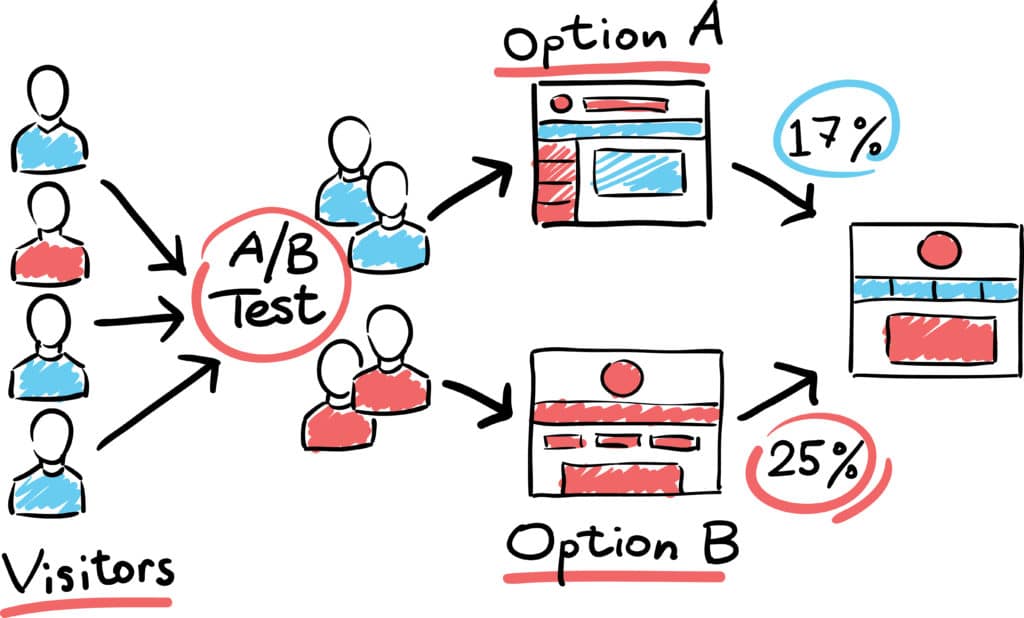
A/B testing, or split testing, is a powerful way to improve your email marketing.
It involves comparing two versions of an email to see which one performs better. This helps you understand what resonates best with your audience.
When A/B testing your emails, consider testing different elements such as subject lines, email copy, images, CTAs, and send times.
For example, you might test a subject line with an emoji against one without or compare a longer email with a shorter one.
Once you’ve run your test, analyze the results to see which version had higher open rates, click-through rates, or conversions. Use these insights to refine your email strategy and continuously improve your campaigns.
11. Track the Right Metrics
Speaking of analytics and refining strategies, let’s discuss which email metrics to track.
Tracking the right metrics is essential for understanding campaign performance and making data-driven decisions to improve it.
Key email marketing metrics to monitor include:
- Open rate: The percentage of recipients who open your email. This helps see the effectiveness of your subject lines.
- Click-through rate (CTR): The percentage of recipients clicking links within your email. This indicates how engaging your content and CTAs are.
- Conversion rate: The percentage of recipients who complete a desired action, such as purchasing. This measures the overall success of your email in driving actions.
- Bounce rate: The percentage of emails that couldn’t be delivered. A high bounce rate could indicate issues with your email list quality or that you need an SMTP email service.
- Unsubscribe rate: The percentage of recipients who opt out of your emails. This can help you understand whether your content is relevant and engaging.
Using this data, you can refine your strategy by identifying what works and what doesn’t.
For example, if your open rates are low, try testing different subject lines. If your CTR is low, consider improving your content or CTAs.
You can optimize your email campaigns for better performance and higher engagement by continuously monitoring and analyzing these metrics.
For WordPress users, MonsterInsights is the best tool for monitoring your website’s performance and email marketing efforts.
As the top Google Analytics plugin for WordPress, MonsterInsights makes connecting Google Analytics with your site easy.
It provides clear, straightforward reports on your website activities, including insights from your email marketing campaigns, all within your WordPress dashboard.
With MonsterInsights, tracking critical data and creating detailed reports is simple. You can set up eCommerce reports, track form submissions, monitor link clicks and much more.
After linking your website to Google Analytics, MonsterInsights allows you to track the number of people who click to send you an email and the number who click the links in your emails.
To learn more about email tracking, check out How to Set Up Google Analytics Email Tracking (4 Easy Steps).
Get started with MonsterInsights now!
12. Connect with Social Media
Integrating social media with your email marketing can amplify your reach and engagement. Connecting your email campaigns with social media can create a more cohesive and powerful marketing strategy.
To integrate social media with email marketing, include social media buttons in your emails that link to your profiles. This makes it easy for your subscribers to follow you on different platforms.
You can also share snippets of your emails on social media to attract more followers and encourage sign-ups.
Another effective tactic is to encourage social sharing. Add social sharing buttons to your emails, allowing recipients to share your content with their networks. You can also create incentives for sharing, like offering a discount to every friend referred through social media.
Connecting your email marketing with social media can expand your audience, increase engagement, and drive more traffic to your website.
13. Provide Value in Every Email
Ensuring your emails are valuable to subscribers is key to maintaining their interest and engagement. When your audience knows they can expect useful and relevant content from you, they are likelier to open and interact with your emails.
Focus on content that addresses your subscribers’ needs and interests to provide value. This can include:
- Educational content: Share tips, how-tos, and industry insights that help your audience solve problems or learn something new.
- Exclusive offers: Provide special discounts, early access to sales, or members-only deals that make your subscribers feel appreciated.
- Updates and news: Keep your audience informed about your latest products, services, or company news. This helps build a connection and keeps them engaged with your brand.
- Entertaining content: To make your emails enjoyable, include interesting stories, fun facts, or engaging visuals.
By consistently delivering valuable content, you can build trust and loyalty with your subscribers, leading to higher engagement and better results for your email marketing campaigns.
14. Optimize for Mobile
With many people checking emails on their phones, optimizing your emails for mobile is crucial. Mobile-friendly emails ensure a good user experience, no matter the device.
Start with a responsive design that adjusts to different screen sizes to make your emails mobile-friendly.
Keep your email layout simple and single-column to prevent issues with readability and navigation.
Use large, easy-to-tap buttons for your calls-to-action (CTAs), and make sure your text is large enough to read without zooming in.
Images should be optimized for fast loading and scale properly on smaller screens.
Remember to test your emails on various devices and email clients to ensure they look good everywhere.
15. Use Customer Feedback and Surveys
Last but not least, you want to know your subscribers.
Gathering feedback through emails is a great way to understand your audience’s needs and preferences.
By including surveys or asking for feedback directly in your emails, you can gain valuable insights into what your subscribers like and what they want to see more of.
You can send out short surveys or include a quick poll in your emails to gather feedback.
Ask specific questions about their experience with your emails, what type of content they find most valuable, and any suggestions they have for improvement.
The best tool for WordPress users is UserFeedback. It’s the best user feedback plugin on the market, making it super easy to create stand-out surveys and polls.
Once you have collected the feedback, analyze it to identify common themes and areas for improvement.
Use this information to tailor your content, adjust your email frequency, and refine your overall strategy.
And that’s it!
We hope you liked this article on effective email strategies for small businesses. If you enjoyed it, be sure also to read:
- 26 Best Digital Marketing Tools for Big Growth
- 17 Email Marketing Best Practices You Need To Use
- 9 Email Marketing Metrics and KPIs to Watch
- How to Build an Email List: 16 Highly Effective Ways
Haven’t you tried MonsterInsights yet? Get started today!
And don’t forget to follow us on X, Facebook and YouTube for more helpful Google Analytics tips.
